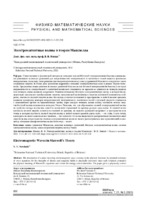| dc.contributor.author | Невдах, В. В. | |
| dc.coverage.spatial | Минск | ru |
| dc.date.accessioned | 2022-06-09T12:49:19Z | |
| dc.date.available | 2022-06-09T12:49:19Z | |
| dc.date.issued | 2022 | |
| dc.identifier.citation | Невдах, В. В. Электромагнитные волны в теории Максвелла = Electromagnetic Waves in Maxwell’s Theory / В. В. Невдах // Наука и техника. – 2022. – № 3. – С. 222-228. | ru |
| dc.identifier.uri | https://rep.bntu.by/handle/data/112394 | |
| dc.description.abstract | Существующее в физической литературе описание плоской бегущей электромагнитной волны одинаковыми решениями волновых уравнений для напряженностей электрического и магнитного полей является физически некорректным, поскольку такие решения противоречат физическому смыслу уравнений Максвелла и нарушают закон сохранения энергии. В статье дано физически корректное описание электромагнитных волн в рамках теории Максвелла. Предложены новые решения волновых уравнений Максвелла для бегущей электромагнитной волны, в которых напряженности ее электрической и магнитной компонент изменяются во времени со сдвигами на четверть периода и на четверть длины волны по координате. Решения описывают бегущую электромагнитную волну, в которой последовательно происходит преобразование энергии электрической компоненты в энергию магнитной компоненты и обратно; плотность полной энергии волны без потерь остается постоянной в пространстве в любой момент времени; взаимная ориентация векторов напряженностей электрического, магнитного полей и фазовой скорости изменяется с левовинтовой тройки на правовинтовую тройку через каждую четверть длины волны; плотность потока энергии бегущей волны описывается вектором Умова. Показано, что для образования стоячей электромагнитной волны не требуется потеря полуволны одной из компонент отраженной на границе раздела сред волны. В стоячей волне плотность полной энергии остается постоянной по времени, но является функцией координат: в пространстве есть точки, в которых плотность полной энергии волны в любой момент времени равна нулю, – это узлы, и есть точки, в которых она имеет максимальное значение, – это пучности. Из-за неоднородности распределения плотности полной энергии волны в пространстве стоячая электромагнитная волна не может рассматриваться как гармонический осциллятор, а бегущая электромагнитная волна без потерь – может. | ru |
| dc.language.iso | ru | ru |
| dc.publisher | БНТУ | ru |
| dc.title | Электромагнитные волны в теории Максвелла | ru |
| dc.title.alternative | Electromagnetic Waves in Maxwell’s Theory | ru |
| dc.type | Article | ru |
| dc.identifier.doi | 10.21122/2227-1031-2022-21-3-222-228 | |
| local.description.annotation | The description of a plane traveling electromagnetic wave existing in the physical literature by identical solutions of wave equations for the strengths of electric and magnetic fields is physically incorrect, since such solutions contradict the physical meaning of Maxwell’s equations and violate the energy conservation law. The paper gives a physically correct description of electromagnetic waves in the framework of Maxwell’s theory. New solutions of Maxwell’s wave equations for traveling electromagnetic wave are proposed, in which the strength of its electric and magnetic components change in time with shifts of a quarter of the period and a quarter of the wavelength along coordinate. The solutions describe a traveling electromagnetic wave, in which the energy of the electrical component is sequentially converted into the energy of the magnetic component and vice versa; the total energy density of the lossless wave remains constant in space at any time; the mutual orientation of the intensity vectors of the electric, magnetic fields and phase velocity changes from a left-handed three to a right-handed three every quarter of the wavelength; the energy flux density of the traveling wave is described by the Umov vector. It is shown that the formation of a standing electromagnetic wave does not require the loss of half a wave of one of the components of the wave reflected at the interface between the media. In a standing wave, the total energy density remains constant in time, but it is a function of coordinates: there are points in space where the total energy density of the wave at any time is zero – these are nodes, and there are points where it has a maximum value – these are antinodes. Due to the inhomogeneity of the distribution of the total energy density of the wave in space, a standing electromagnetic wave cannot be considered as a harmonic oscillator, but a lossless traveling electromagnetic wave can. | ru |

